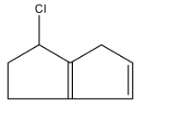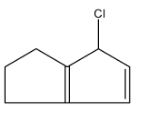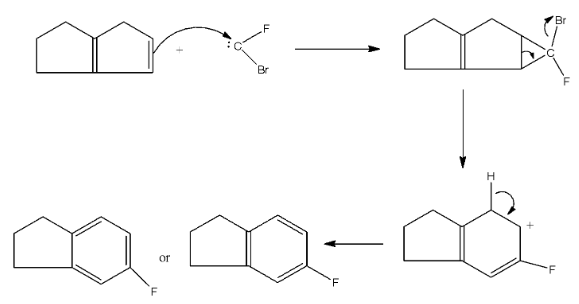
What is the product (Q) of the following reaction?

A.

B.

C.

D.






Answer
525k+ views
Hint: When CHFBrI will react with tertiary butoxide then, there is the formation of carbene, this carbine will react with the reactant molecule and insert itself in the reactant and then there will be the formation of carbocation leaving the most electronegative on the ring.
Complete step by step answer: Let us first see, what is the reaction between the molecules written on the arrow in the reaction, so, there are two compounds written, i.e., CHFBrI and t-BuO. CHFBrI is Bromochloroiodomethane and t-BuO is tertiary butoxide, so these react together, then there will be the formation of carbene in which the carbon atom will have a lone pair, fluorine and bromine atom. The reaction is given below:
$CHFBrI\xrightarrow{t-Bu{{O}^{-}}}\overset{-}{\mathop{C}}\,FBrI\xrightarrow{{{I}^{-}}}:CFBr$
This carbene will attack the reactant. The given reactant is a fused two pentene rings, so the carbine will attack one of the double bonds and will form a six-membered ring. After the formation of a six-membered ring, the bromine will leave and there will be the formation of a carbocation. This carbocation will be balanced by the formation of a double bond by the removal of a hydrogen atom from the ring. The series of reaction is given below:

So, the obtained product is equal to the compounds given in option (d). Therefore, the correct answer is an option (d).
Note: In the formation of carbene, the iodine was removed because the electronegativity of iodine is less than the electronegativity of bromine and fluorine. So, the atom that has the highest electronegativity will retain the aromatic ring.
Complete step by step answer: Let us first see, what is the reaction between the molecules written on the arrow in the reaction, so, there are two compounds written, i.e., CHFBrI and t-BuO. CHFBrI is Bromochloroiodomethane and t-BuO is tertiary butoxide, so these react together, then there will be the formation of carbene in which the carbon atom will have a lone pair, fluorine and bromine atom. The reaction is given below:
$CHFBrI\xrightarrow{t-Bu{{O}^{-}}}\overset{-}{\mathop{C}}\,FBrI\xrightarrow{{{I}^{-}}}:CFBr$
This carbene will attack the reactant. The given reactant is a fused two pentene rings, so the carbine will attack one of the double bonds and will form a six-membered ring. After the formation of a six-membered ring, the bromine will leave and there will be the formation of a carbocation. This carbocation will be balanced by the formation of a double bond by the removal of a hydrogen atom from the ring. The series of reaction is given below:

So, the obtained product is equal to the compounds given in option (d). Therefore, the correct answer is an option (d).
Note: In the formation of carbene, the iodine was removed because the electronegativity of iodine is less than the electronegativity of bromine and fluorine. So, the atom that has the highest electronegativity will retain the aromatic ring.
Recently Updated Pages
A man running at a speed 5 ms is viewed in the side class 12 physics CBSE

State and explain Hardy Weinbergs Principle class 12 biology CBSE

Which of the following statements is wrong a Amnion class 12 biology CBSE

Two Planoconcave lenses 1 and 2 of glass of refractive class 12 physics CBSE

The compound 2 methyl 2 butene on reaction with NaIO4 class 12 chemistry CBSE

Bacterial cell wall is made up of A Cellulose B Hemicellulose class 12 biology CBSE

Trending doubts
What are the major means of transport Explain each class 12 social science CBSE

Which are the Top 10 Largest Countries of the World?

Draw a labelled sketch of the human eye class 12 physics CBSE

Explain sex determination in humans with line diag class 12 biology CBSE

Give 10 examples of unisexual and bisexual flowers

State the principle of an ac generator and explain class 12 physics CBSE




